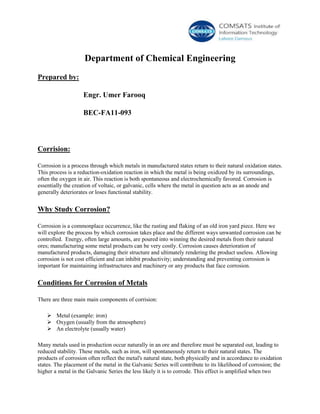
Corrision word doc.
- 1. Department of Chemical Engineering Prepared by: Engr. Umer Farooq BEC-FA11-093 Corrision: Corrosion is a process through which metals in manufactured states return to their natural oxidation states. This process is a reduction-oxidation reaction in which the metal is being oxidized by its surroundings, often the oxygen in air. This reaction is both spontaneous and electrochemically favored. Corrosion is essentially the creation of voltaic, or galvanic, cells where the metal in question acts as an anode and generally deteriorates or loses functional stability. Why Study Corrosion? Corrosion is a commonplace occurrence, like the rusting and flaking of an old iron yard piece. Here we will explore the process by which corrosion takes place and the different ways unwanted corrosion can be controlled. Energy, often large amounts, are poured into winning the desired metals from their natural ores; manufacturing some metal products can be very costly. Corrosion causes deterioration of manufactured products, damaging their structure and ultimately rendering the product useless. Allowing corrosion is not cost efficient and can inhibit productivity; understanding and preventing corrosion is important for maintaining infrastructures and machinery or any products that face corrosion. Conditions for Corrosion of Metals There are three main main components of corrision: Metal (example: iron) Oxygen (usually from the atmosphere) An electrolyte (usually water) Many metals used in production occur naturally in an ore and therefore must be separated out, leading to reduced stability. These metals, such as iron, will spontaneously return to their natural states. The products of corrosion often reflect the metal's natural state, both physically and in accordance to oxidation states. The placement of the metal in the Galvanic Series will contribute to its likelihood of corrosion; the higher a metal in the Galvanic Series the less likely it is to corrode. This effect is amplified when two
- 2. metals at opposite ends of the Galvanic Series are in contact: the higher metal will increase its resistance while the lower will corrode more, as seen in sacrificial anodes. Particular areas of stress along the metal's surface area will face corrosion more quickly because that metal is more active than the rest of the unstrained metal. Other environmental factors contribute to corrosion such as pH, salt concentration, and oxygen concentration, along with the velocity of the water and temperature. How Corrosion Occurs Corrosion can occur in two general ways; over the entire surface of the metal (Generalized Corrosion), or in local spots or areas (Localized Corrosion). Generalized Corrosion: Typically never happens, aside from in acidic conditions. This uniform corrosion over the entire surface of the metal is rare and leads to overall thinning which has little effect outside of fatigue and stress conditions. Localized Corrosion: The most common, and most detrimental, form of localized corrosion is pitting. Pitting is when the attack happens in one single location on the surface and creates a pit, or small cavity, in the metal. This type of corrosion attack is hard to prevent, engineer against, and often times difficult to detect before structural failure is met due to cracking. Pipes are often compromised due to pitting. Understanding Corrosion as an Electrochemical Process (a Voltaic Cell) Corrosion happens through a series of reduction-oxidation reactions, similar to those of a battery. The metal being corroded acts as the anode; the metal is oxidized, forming metal ions and free electrons. The free electrons reduce the oxygen, often times forming hydroxide, and providing a complimentary cathodic reaction. The dissolution of the metal at the anode has two possible outcomes; the metal ions can go into solution, becoming hydrated, or the metal ions can form a solid compound that collects on the surface. In the former case, further oxidation of the metal ions can occur and an open pit can form. In the latter case, a protective barrier may be formed and the collection of solid metal ions will inhibit further corrosion. Reaction: Fe2+(aq)+2OH−(aq)⟶Fe(OH)2;(s) 4Fe(OH)2(s)+O2(g)+2H2O(l)⟶Fe(OH)3(s)
- 3. Galvanic Corrosion Galvanic corrosion involves two metals that are electrochemically dissimilar and an electrolyte to carry an electrical current. The subsequent reactions model a galvanic cell; reduction-oxidation reactions occur in a way similar to those of batteries. Typically, the metal that is lower on the Galvanic Series will act as the anode and corrode faster than without the presence of the second metal, while the second metal gains a stronger resistance to corrosion. These reactions and their directions can change or be altered due to the environment. Corrosion prevention Corrosion can be prevented through using multiple products and techniques including painting, sacrificial anodes, cathodic protection (electroplating), and natural products of corrosion itself. Painting: The paint forms a barrier between the metal and the environment, namely moisture. Sacrificial anodes: Utilization of a metal lower on the Galvanic Series to be attacked first, instead of the metal in use. The sacrificial anode can be replaced as needed. Passivation: Some corrosion processes will create solid metal compounds that will coat the initial site of corrosion and prevent further corrosion at that site. Cathodic Protection: In the illustration below the iron is coated with a thin layer of zinc which is acting as a sacrificial layer for the iron. Instead of the the iron corroding, the Zn acts as the sacrificial anode in the cell and protects the iron.